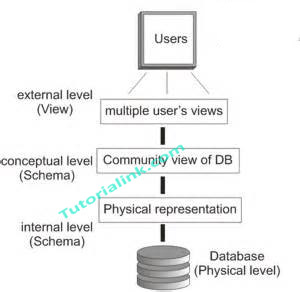Three-level ANSI SPARC Database Architecture
The Architecture of most of commercial dbms are available today is mostly based on this ANSI-SPARC database architecture .
ANSI SPARC THREE-TIER architecture has main three levels:
- Internal Level
- Conceptual Level
- External Level
These three levels provide data abstraction ;means hide the low level complexities from end users .
A database system should be efficient in performance and convenient in use.
Using these three levels,it is possible to use complex structures at internal level for efficient operations and to provide simpler convenient interface at external level.

1. Internal level:
- This is the lowest level of data abstraction.
- It describes How the data are actually stored on storage devices.
- It is also known as physical level.
- It provides internal view of physical storage of data.
- It deals with complex low level data structures,file structures and access methods in detail.
- It also deals with Data Compression and Encryption techniques,if used.
2. Conceptual level:
- This is the next higher level than internal level of data abstraction.
- It describes What data are stored in the database and What relationships exist among those data.
- It is also known as Logical level.
- It hides low level complexities of physical storage.
- Database administrator and designers work at this level to determine What data to keep in database.
- Application developers also work on this level.
3. External Level:
- This is the highest level of data abstraction.
- It describes only part of the entire database that a end user concern.
- It is also known as an view level.
- End users need to access only part of the database rather than entire database.
- Different user need different views of database.And so,there can be many view level abstractions of the same database.
Advantages of Three-tier Architecture:
- The main objective of it is to provide data abstraction.
- Same data can be accessed by different users with different customized views.
- The user is not concerned about the physical data storage details.
- Physical storage structure can be changed without requiring changes in internal structure of the database as well as users view.
- Conceptual structure of the database can be changed without affecting end users.

Ask Question